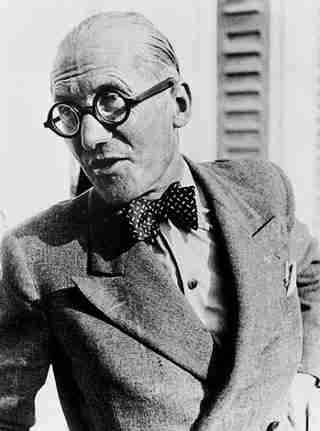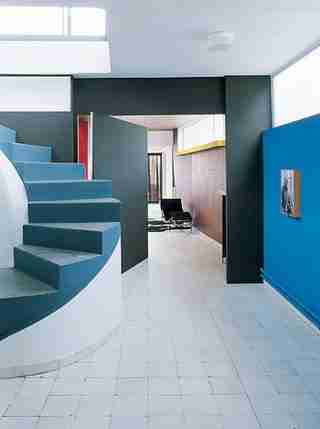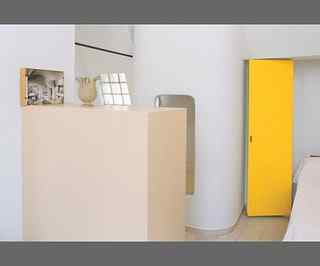Le Corbusier

The History
Born Charles Edouard Jeanneret in 1887, the designer rechristened himself Le Corbusier after his maternal grandfather in Paris in 1920. He began his career as a metal engraver, but was encouraged to take on architecture and subsequently built his first house at the age of 18. He joined the architectural offices of Auguste Perret in Paris, working mainly with concrete and reinforced steel. Le Corbusier later branched out and published many books on the functionality and simplicity of architectural design, codesigned furniture, and became heavily involved in urban planning.
A portrait of Le Corbusier. (July 1999)

Le Corbusier in Paris
In 1931 Le Corbusier designed an apartment building in Paris with a penthouse for himself and his wife, Yvonne Gallis, a young fashion model from Monaco. Their restored residence is now open to the public.
The Paris apartment entrance hall; beyond the pivoting door is the main living area. (July 1999)

Vaulted Rooms
A standard architectural element of a Le Corbusier–designed building, the shallow vault, constructed from molded concrete, was typically inserted into his aerielike spaces to make them appear and feel even lighter.
The vaulted master bedroom of Le Corbusier's Paris apartment. (July 1999)
Le Corbusier Furniture
In 1928 Le Corbusier began designing furniture for his buildings, in part collaborating with his cousin Pierre Jeanneret and Charlotte Perriand. The team created a series of steel furniture that would later become iconic pieces of the 20th century. The series, titled "Equipment for Living," included the B 302 swivel chair, the B 301 armchair, and the B 306 chaise longue (pictured), which Le Corbusier called the "relaxing machine."
The B 306 chaise longue, crafted with steel and leather by Le Corbusier, Pierre Jeanneret, and Charlotte Perriand. (May 2004)
The Curutchet House
The only residence designed by Le Corbusier in South America, the Curutchet House, in La Plata, Argentina, was commissioned in 1948 by Pedro Domingo Curutchet, a surgeon. The client wanted "a small masterpiece of simplicity, convenience, and harmony"; it took six years to complete the home.
Le Corbusier paired varnished wood with opaque glass for the nurse's room window. The terrace is off the living room; the top two floors contained the living spaces. (July 2000)
Le Corbusier the Painter
The architect tried to spend every morning painting before leaving for his drafting office on the rue de Sèvres. By the mid-1930s he would branch into sculpture.
Le Corbusier in his art studio. (July 1999)
The 1950s
A shift from spartan and lightweight Purism to heavier brick and reinforced concrete marked Le Corbusier's career in the 1950s. Splashes of bright color were often juxtaposed against rough, unfinished textures.
The curved exterior wall of a bathroom plays with the adjacent hard, straight lines. (July 2000)
Villa Savoye
Completed in 1931 near Paris, the Villa Savoye was restored in 1987 for the centennial celebration of Le Corbusier's birth. "The house is a box in the air, pierced all around, with a window extending lengthwise," he wrote. "Under the box runs a driveway. Cars can come and go by means of a hairpin turn." According to the architect, the house was designed "to do away with any notion of a 'front' or 'back' or 'side.'"
The Villa Savoye, in Poissy, France. (May 1986)